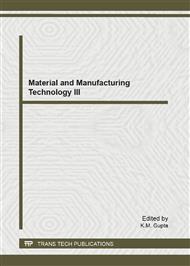p.595
p.600
p.607
p.612
p.617
p.623
p.627
p.632
p.637
Mathematical Modelling and Optimization of Photochemical Machining
Abstract:
Photochemical Machining is a novel machining process capable of processing wide range of hard-to-machine materials. This research addresses modelling and optimization of the process parameters for this machining technique. To model the process a set of experimental data has been used to evaluate the effects of various parameter settings in machining of SS316L. The process variables considered here include etchant temperature, time and concentration. Undercut, as one of the most important output characteristics, has been evaluated based on different parameter settings. The full factorial method and regression modelling are used in order to establish the relationships between input and output parameters. The effect of control parameters on undercut was analysed using Analysis of Variance (ANOVA) technique and their optimal conditions were evaluated. It was found that etchant temperature and etching time are the most significant factors for undercut.
Info:
Periodical:
Pages:
617-622
Citation:
Online since:
July 2012
Authors:
Price:
Сopyright:
© 2012 Trans Tech Publications Ltd. All Rights Reserved
Share:
Citation:


